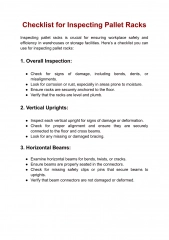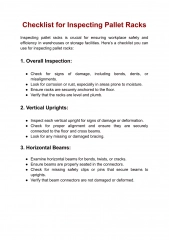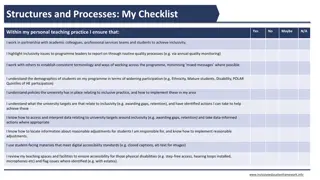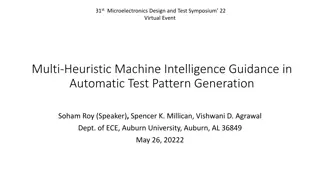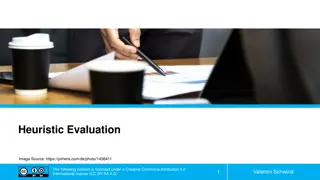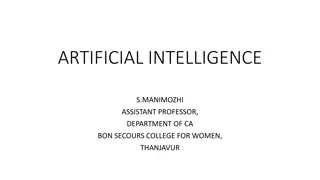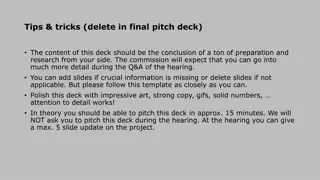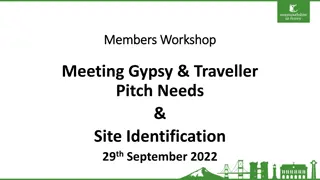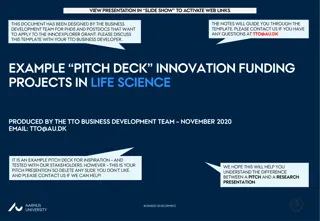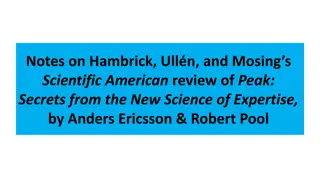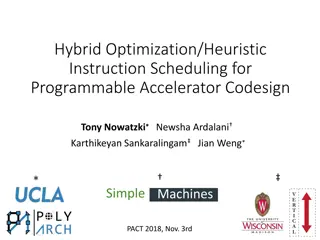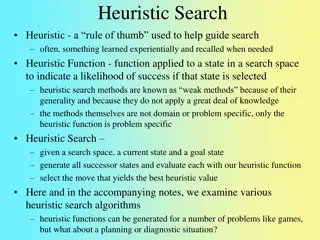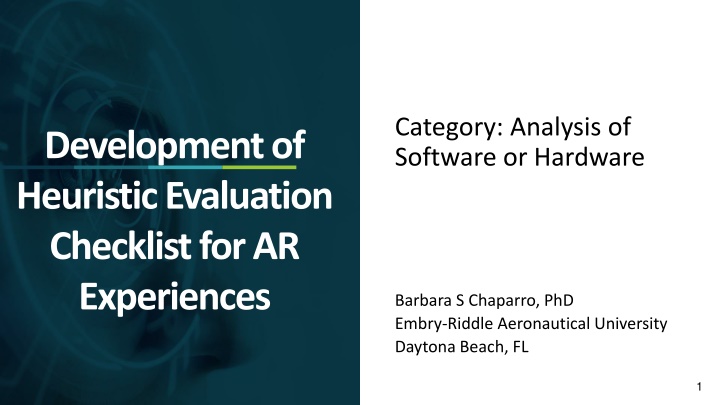
Development of Heuristic Evaluation Checklist for AR Experiences
This research aims to address the lack of standards for evaluating AR solutions by developing and validating standard heuristics. By conducting literature reviews, correlating AR features with usability attributes, and involving experts and users in validation, the study seeks to improve the usability and user experience of enterprise wearable AR platforms. Providers, safety managers, and regulatory agencies can benefit from this research to enhance AR solutions.
Download Presentation

Please find below an Image/Link to download the presentation.
The content on the website is provided AS IS for your information and personal use only. It may not be sold, licensed, or shared on other websites without obtaining consent from the author. If you encounter any issues during the download, it is possible that the publisher has removed the file from their server.
You are allowed to download the files provided on this website for personal or commercial use, subject to the condition that they are used lawfully. All files are the property of their respective owners.
The content on the website is provided AS IS for your information and personal use only. It may not be sold, licensed, or shared on other websites without obtaining consent from the author.
E N D
Presentation Transcript
Category: Analysis of Software or Hardware Development of Heuristic Evaluation Checklist for AR Experiences Barbara S Chaparro, PhD Embry-Riddle Aeronautical University Daytona Beach, FL 1
Problem this Research Would Address There is currently a lack of standards/guidelines for the evaluation of AR solutions Heuristic Evaluation is a method that has been used in many software domains to identify usability issues PROBLEM: Standard heuristics need to be developed and validated to allow a range of AR experiences to be evaluated 2
Problem this Research Would Address Dey, A., Billinghurst, M., Lindeman, R. W., & Swan, J. (2018). A Systematic Review of 10 Years of Augmented Reality Usability Studies: 2005 to 2014. Frontiers in Robotics and AI, 5, 37. 3
Whose problem would be addressed? Providers of enterprise wearable AR platforms would be able to more quickly/reliably Assess usability and user experience (UX) Iterate design/development Develop more satisfying, efficient, and effective solutions Enterprise safety managers would Benefit from better designed solutions Regulatory agencies or groups would Appreciate the standardization and overall improvement in quality 4
How would this research be conducted? 1. Literature review Existing heuristics and guidelines Experimental findings 2. Correlation of AR features to usability/UX attributes and heuristics 3. Checklist items developed for each heuristic 4. Validation Experts Users with AR experiences 5. Refinement 5
How would this research be conducted? de Paiva Guimar es, M., & Martins, V. F. (2014, May). A checklist to evaluate Augmented Reality Applications. In 2014 XVI Symposium on Virtual and Augmented Reality (pp. 45-52). IEEE. 6
How would this research be conducted? Areas to Consider: User interface design of AR components Contrast/legibility on variety of backgrounds Affordance Consistency Location of AR elements Comfort of device Alignment between physical and virtual environments Ease of interaction Etc 7
How would this research be conducted? Deliverables - Literature review white paper - Validation results & discussion white paper - Final heuristic checklist(s) 8
Benefits to AREA Members AREA members will be able to more quickly assess the usability/UX of emerging AR experiences Long term impacts of this research: Increased user focus in development Improved usability/UX solutions Increased user satisfaction and acceptance of AR technology 9

